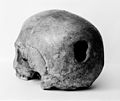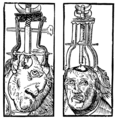Cranial drill
 High-speed pneumatic surgical drill with cranial drill bit | |
| Occupation | |
|---|---|
Activity sectors | Surgery, Craniotomy, Craniectomy |
| Description | |
Fields of employment | Hospitals, Clinics, Emergency Medicine |
A cranial drill, also known as a craniotome, is a tool for drilling simple burr holes (trepanation) or for creating larger openings in the skull. This exposes the brain and allows operations like craniotomy and craniectomy to be done. The drill itself can be manually or electrically driven, and primarily consists of a hand piece and a drill bit which is a sharp tool that has the form similar to Archimedes screw, this instrument must be inserted into the drill chuck to perform holes and remove materials. The trepanation tool is generally equipped with a clutch which automatically disengages once it touches a softer tissue, thus preventing tears in the dura. For larger openings, the craniotome is a surgical instrument that has replaced manually pulled saw wires in craniotomies from the 1980s.
History
Cranial drill
The oldest evidence of a hole being applied on a human's brain with a drill dates from c. 4,000 B.C.[1] The oldest cranial drilling instrument was found in France, and subsequent use evidenced by the Ancient Romans, Egyptians, and in Trepanation in Mesoamerica. The practice of trepanning is also evidenced from Ancient Greece, North and South America, Africa, Polynesia and the Far East. The conceivable reasons why ancient humans developed the technique of drilling the head could be religious, ritual or medical factors.[2] The first trepanning procedure consisted of different types or tools and techniques: at the beginning the only material that was available for use was a sharp and carved rock. The development of The Hippocratic Corpus, written in the fifth century B.C., is the first written source that can be found about trepanning. The aim of the procedure described in "on Wounds in the head" was to allow the stagnant blood to escape from the head through a hole. The drill that was used at the time is similar to the modern ones, but was operated by hand rotation.[3]
In the 15th century, people began to believe that drilling was a cure for mental problems due to a magical stone of madness or stone of folly in the head, which had to be removed. Paintings that portray this practice exist, the most significate ones include The Extraction of the Stone of Madness c. 1488-1516 by Hieronymus Bosch and A Surgeon Extracting the Stone of Folly by Pieter Huys.[4]

From the Renaissance ages, cranial drilling continued to evolve and surgical practice was used less due to the high mortality rate. It was used only for some interventions, such as the treatment of hemorrhages, depressed fractures and penetrating the head. Also the name for the surgery changed from trepanning to craniotomy.
In the late 1860s, E.G. Squier a well-educated man who was an expert in archaeology discovered a skull in an ancient Inca cemetery. This specific skull was anticipated to be of pre-Columbian era. The skull exhibited a large rectangle-shaped hole on the top. The skull was brought it back to the United States, and his findings presented to the New York Academy of Medicine. Squier argued that the brain was injected with a tool called a burin which was used on woods and metals before. Traces showed human hand prints. He concluded that the skull and brain evidenced recovery from prehistoric brain surgery, potentially prolonging the patients life.[5]
Metallurgy was a technique that allowed the use of saws and scalpels. Other cultures came about experimenting through the usage of glass.[4]
Dr Bart Hughes has declared that evolution caused a decrease in partial brain functions, mainly in the human consciousness. Whereas others increased, like speech and reasoning. The changes in performance are due to the enhancement of the extensiveness of blood. Which is located in the capillaries of the human brain.[6] These performances in the human brain are related to a higher level of vision. That a child still copes with because their membranes around the brain let them get in touch with dreams, imagination and intense perception.[6] To reach ones goal, to increase his level of vision one must decideto remove a part of there skull by cutting a small disc of its bone. Hughes, conducted his first operation in 1962 on himself using an electric drill, surgical knife and a hypodermic needle.[7] Amongst other surgeries on fellow collogues he operated. The medical and legal authorities declared that his discovery was awful and Hughes was sent to Dutch lunatic asylum.[6]

Improvements in technology are replacing the basic hand cranial drill by an robotic drill. The robotic drill is a high pace drill that will allow surgeons to experience performance over 50 times faster. The robotic drill is still not used in the point of time.[8]
Application
A cranial drill is currently used for Neurosurgery operations. The procedure of trepanning is applied to patients who suffer for example a traumatic brain injury or a stroke. In these cases, it might be necessary to drill a hole in the skull to be able to access the dura mater or the brain itself, and to relieve brain pressure or blood clots.[9] With the use of modern types of cranial drills, surgeons are able to create holes in the bone structure without traumatizing underlying brain tissue.[10] The drill's working tool tip consists of a spiral blade that is framed by a guard device with an angled cranium guide that rests against the inner layer of the skull bone. The dura guard pushes the dura mater downward while the craniotome is moved forward thus preventing dural tearing.[11]
Types and design
A cranial drill is an essential instrument used by surgeons to drill in to the skull bone. Various types of drills are used by surgeons from the craniotomy, or oral surgeries. The cranial drill can be differentiated by the examinations of what kind of surgery have to be performed. They can be manually operated, operated by electricity, or by pneumatic motors.
Manual cranial drill

The rotating crank is typically connected to several cogs that sets pressure on the skull. This specific drill is not connected to any external power, and is used very little in today's operations.[12] The manual cranial drill is the most used and predominant type of drill in surgery, and performs manually. Which, has an adjusted stopper based on the setting and where the bone is the most thickest to prevent plunging. Surgeons use this drill manually without any other procedures. Surgeons that use a hand-cranked drill often are required to employ a lot of upper body strength.
Electric cranial drill
The electric cranial drill is powered either by a battery or by electricity via wall sockets.
Pneumatic cranial drill
The pneumatic motor is known for its great speed, which makes surgery much easier and faster. It is driven by expanding compressed air. The use of this kind of mechanism has many advantages such as the ease of use through high peak velocities. Thanks to superior torque, this system has great performance and it is essential for complex revision operations. The surgical procedure is shorter than usual, so patients spend less time under anesthesia .[13] Pneumatic high-speed craniotomes usually run at 40,000 to 80,000 rpm and have greatly facilitated intracranial approaches in neurosurgery. They are also employed to temporarily remove the vertebral arch in laminotomy.[13]
Scientific progress
Technological progress to reduce surgery time and minimize risks for patients during surgery have been introduced in the field of cranial drills, primarily from machining.
CAD/CAM
CAD/CAM stands for computer-aided design/computer-aided manufacturing. Recentely in the medical field as well. It is used by surgeons to simplify and ease surgeries: in the case of trepanning, a processor collects information from 2D images, and then turns them into 3D images. The processor codifies this information so that the drill can, without any trouble, pierce the correct portion of the skull.[14]
Photo gallery
-
Manual drill during the 18th century
-
Edinburgh Skull, trepanning showing hole in back of skull
-
A human skull showing signs of Trepanning
-
Celtic museum in Hallein ( Salzburg ). Human skull with trepanation
-
Engraving by Peter Treveris of a trepanation. From Heironymus von Braunschweig's Handywarke of surgeri
-
Trepanation illustration France 1800s
-
Cranial trephine with two bits, Europe, 1601-1800
-
Decompressive Craniectomy
See also
- Instruments used in general surgery
- Retractor (medical)
- Surgical scissors
- Deep brain stimulation
- Intracranial pressure
References
- ^ Cohut, Maria. "Skull-drilling: The ancient roots of modern neurosurgery". Medical News Today. Retrieved 28 September 2018.
- ^ Wylie, Robin. "Why our ancestors drilled holes in each other's skulls". BBC. Retrieved 10 November 2018.
- ^ Gross, Charles G. "Trepanation from the Paleolothic to the internet" (PDF). Archived from the original (PDF) on 24 September 2015. Retrieved 10 November 2018.
- ^ a b Ferreira, Becky. "Madness Stones to New Age Medicine: A History of Drilling Holes in Our Heads". Motherboard. Retrieved 10 November 2018.
- ^ Fawcett, Kristin. "Trepanation: The History of One of the World's Oldest Surgeries". MentalFloss. Retrieved 26 November 2018.
- ^ a b c Michell, John. "The People With Holes In Their Heads". MIT. Retrieved 22 November 2018.
- ^ "An illustrated history of trepanation". Science Blog. Retrieved 22 November 2018.
- ^ Villaluz, Kathleen (2017-05-08). "This Robotic Drill Can Perform Complex Cranial Surgeries 50 Times Faster". INTERESTING ENGINEERING. Retrieved 1 November 2018.
- ^ "Trepanation". Encyclopedia.com. Retrieved 10 November 2018.
- ^ Liss, Sam T. "Safe cranial drilling device". Harvard Office of Technology Development. Retrieved 10 November 2018.
- ^ Rogers, Laurel; Lancaster, Ron. "Patent US6506199B2". Google Patents. Retrieved 25 November 2018.
- ^ Treccani. "Trapano". Treccani enciclopedie on line. Retrieved 9 October 2018.
- ^ a b SRM University. "Surgical driller" (PDF). Archived from the original (PDF) on 1 December 2018. Retrieved 10 November 2018.
- ^ Couldwell, William T.; MacDonald, Joel D.; Thomas, Charles L.; Hansen, Bradley C.; Lapalikar, Aniruddha; Thakkar, Bharat; Balaji, Alagar K. "Computer-aided design/computer-aided manufacturing skull base drill". JNS - Journal of Neurosurgery. Retrieved 19 November 2018.








